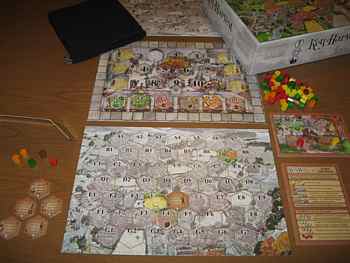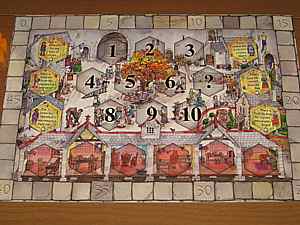Bringing in a Key Harvest
Key Harvest is a fun and interesting strategic tile collecting game designed by Richard Breese (who also designed Reef Encounter and other board games in the Key Series, such as Keydom and Keythedral).
 One of the features of Key Harvest that makes it stand out from other board games is that you can get more points for second best than for first. More on that later.
One of the features of Key Harvest that makes it stand out from other board games is that you can get more points for second best than for first. More on that later.
In Key Harvest, you start with 2 hex-shaped field tiles on your home board. Your main goal is to expand each of these fields by buying tiles adjacent to them. The spaces on your home board each have a unique letter-number identifier: A through G and 1 through 9. There is only one tile for each space, so no one player will ever get every space filled.
Each tile shows a crop (also represented by a barrel bit of the designated color) that can be harvested – wine (red), hops (brown), cider apples (orange), vegetables (green), and wheat (yellow). These crops are essentially the currency of the game.
There is a central board containing a row of 6 field tiles in a section called the land registry. There are 10 spaces for event tiles; these help determine how long the game will take as each player gets 2 more turns after the 10th event tile is played. Finally there are spaces for 6 high-value helper tiles.
The field and event tiles are drawn as needed from a bag (provided). When that 10th event tile is drawn, each player gets 2 more turns, and then the game is done.
On a turn, you can perform 1 or 2 of these actions:
- Harvest your adjacent crop tiles, by flipping them over and collecting one matching barrel for each.
- Place or remove a helper tile. Each player starts with 6 of his own helper tiles besides those on the central board.
- Transfer 1 or 2 tiles from the land registry to a personal side board called the store.
- Transfer 1 or 2 tiles from anyone’s store to your personal field board.
 There are some restrictions on these actions. For example, you can’t move tiles from the registry to store to field in the same turn. When placing helpers, which each have a number from 1 through 5, you must position them adjacent to that number of fields (or more) and not next to another helper.
There are some restrictions on these actions. For example, you can’t move tiles from the registry to store to field in the same turn. When placing helpers, which each have a number from 1 through 5, you must position them adjacent to that number of fields (or more) and not next to another helper.
When you move a field tile from the land registry to your store, you must place a bid on it using your barrels. If another player wants that tile, he can match that bid using barrels of the same color and amount and place the tile on his field. You get to keep both your original bid and his matching payment. If no one bought tiles in your store before your next turn, you can put them on your own field, but you must give up the barrels you had bid.
Scoring only occurs at the end of the game. You get points for each helper on your fields and for having a majority of a given type of crop barrels. You probably will get most of your points from the fields themselves, and here again is where second best could be better. You score one point for each tile in your largest connected field, but you score 2 points for each tile in your second largest connected field.
Key Harvest is fun with 2 players, but it can lead to too much barrel counting. It’s too easy to figure out how many of the 12 barrels of each crop your opponent is hiding behind his shield. With 3 or 4 players, this is almost impossible to determine, making the game more challenging and interesting.
When you play Key Harvest, at least for the first several games, keep the rules booklet handy as there are detailed explanations and a few quirky rules that you’ll need to refer to from time to time to make sure you’re playing the game correctly. After my first 3 plays, I don’t think we’ve played everything exactly as intended yet, but we’ve still had a great time each game.
Check the price of Key Harvest on Amazon.
